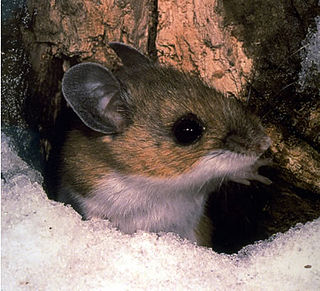Schmidly's deer mouse, is a recently described species of deer mouse from the mountains of western Mexico. It is part of the highly complex and well-studied Peromyscus boylii species complex. The uniqueness of Peromyscus from this area had long been suspected, but was only formalized in 2004 with the publication of its species description. The species was named in honor of David J. Schmidly, a mammalogist and former president of the University of New Mexico.

The Neotominae are a subfamily of the family Cricetidae. They consist of four tribes, 16 genera, and many species of New World rats and mice, predominantly found in North America. Among them are the well-known deer mice, white-footed mice, packrats, and grasshopper mice.
Corydoras simulatus is a tropical freshwater fish belonging to the Corydoradinae sub-family of the family Callichthyidae. It originates in inland waters in South America, and is found in the Upper Meta River basin in Colombia.
The heavenly hill rat is a species of rodent in the family Muridae. It is found only in southwestern Sulawesi, Indonesia, where it has only been found on Mount Lompobatang. Its natural habitat is subtropical or tropical dry forest. It is threatened by habitat loss.
The Chinanteco deer mouse is a species of rodent in the family Cricetidae. It is endemic to Mexico.
Habromys is a genus of rodent in the family Cricetidae, found in Mexico and Central America. It contains these species, all but one of which are threatened or endangered, five of them critically so. H. lophurus is near threatened.
The crested-tailed deer mouse is a species of rodent in the family Cricetidae found in El Salvador, Guatemala, and Mexico.
Nesoryzomys fernandinae, also known as the Fernandina nesoryzomys, Fernandina rice rat, or Fernandina Galápagos mouse, is a species of rodent in the genus Nesoryzomys of family Cricetidae. It is found only on Fernandina in the Galápagos Islands, which it shares with N. indefessus narboroughi. Its natural habitat is subtropical or tropical dry shrubland. The conservation status of this endemic species continues to be investigated.
Nesoryzomys swarthi, also known as the Santiago nesoryzomys or Santiago Galápagos mouse, is a species of rodent in the genus Nesoryzomys of family Cricetidae. It is found only on Santiago in the Galápagos Islands. Its natural habitat is subtropical or tropical dry shrubland.

Handleyomys chapmani, also known as Chapman's oryzomys or Chapman's rice rat, is a species of rodent in the genus Handleyomys of family Cricetidae. It is found only in Mexico. It was previously placed in Oryzomys as Oryzomys chapmani, but has been provisionally transferred to the genus Handleyomys pending the description of a new genus to contain it.

Euryoryzomys lamia, also known as the buffy-sided oryzomys or monster rice rat, is a species of rodent in the family Cricetidae. It is found only in central Brazil, where it lives in forest enclaves within the cerrado. The species' known altitudinal range is from 700 to 900 m. The main threats to its survival are the destruction and fragmentation of its forest habitat.
Burt's deer mouse is a species of rodent in the family Cricetidae. It is endemic to Mexico, where it is found only on Montserrat Island off the east coast of Baja California Sur. The species is threatened by predation by feral cats.
The San Esteban Island mouse is a species of rodent in the family Cricetidae. It is endemic to Mexico, where it is known only from San Esteban Island in the northern Gulf of California.

The Cozumel harvest mouse is a species of rodent in the family Cricetidae. It is endemic to the Mexican island of Cozumel off the Yucatán Peninsula. It is nocturnal and semiareboreal, and lives in dense secondary forest and forest edge habitats. Its population is small, fluctuating and patchily distributed. The species is threatened by predation from feral cats and dogs and introduced boa constrictors, by competition with introduced nonnative rats and mice, and by habitat disturbances caused by hurricanes and floods which periodically strike the island.
Atelopus simulatus is a species of toad in the family Bufonidae. It is endemic to Colombia. Its natural habitats are subtropical or tropical moist montane forests and rivers. It is threatened by habitat loss.
The delicate deer mouse is a species of rodent in the family Cricetidae. It was first described by Michael Carlton, Oscar Sanchez and Guillermina Urbano-Vidales after being discovered in a patch of cloud forest on the Trans-Mexican Volcanic Belt. The species gets its name from its small size and delicate features compared to the other species within the genus Habromys.
The Ixtlán deer mouse is a species of rodent in the family Cricetidae.
The Vogelkop mountain rat, Rattus arfakiensis, is a species of rat native to Indonesia. It is found only in the Bird's Head Peninsula of Papua Province, Indonesia.
Habromys schmidlyi, sometimes known as Schmidly's deer mouse, is a species of rodent in the family Cricetidae found only in Mexico. Its natural habitat is cloud forest in the Sierra de Taxco, on the border of Guerrero and Mexico states, above 1,800 meters elevation.




